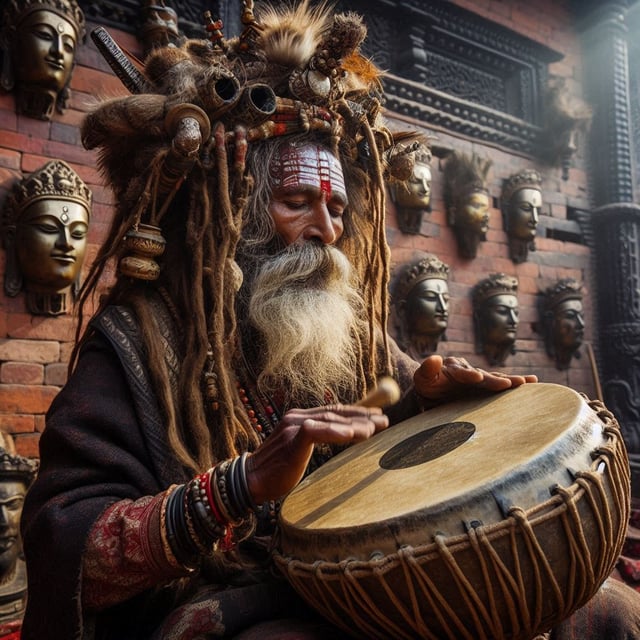Shaman of Nepal

Shamanism is considered the oldest religion in the world and it even gets associated with Paleolithic cave paintings. A shaman is a person who achieves an ecstatic religious experience.
Even though Hinduism and Buddhism have remained the dominant religion, shamans usually exist independently of the systematized religion.
Mountains are considered mysterious and magical and the shaman fits the magical image of Nepal and serves have home to its forms of shaman commonly known as Jhakri around the mountainous range of Nepal.
The Shaman have various names such as Bijuwa in the Magar community, Pawo in the Sherpa community, Dhami in the Khas community, and Bompo in the Tamang Community.
Shamans can gain power by walking barefoot over the burning coals, then half dip in river waters, and meditating for a couple of hours
A strong Shamanic cult can be found in the Karnali Basin southward of the famous Mount Kailash in China.
Dhami is believed to be an incarnation and the knowledge and abilities of Dhami are passed on to another person through a spirit transfer. Dhami is attached to a particular temple or shrine of a specific deity.
The spirit of Dhami can move but the receiver must accept it. Dhami provides consultation, a horoscope reading the judgment, and socio-religious leadership.
Jhakri is transferred from within a clan or through ban jhakri, a paranormal being.
Locals come for remedy of all issues, such as managing conflict, and health concerns, as a result, in a conclave organized by the Health Rights Improvement Project funded by the Korean International Cooperative Agency, all attending dhami-jhankri signed a declaration to ensure equal treatment to women even when they are menstruating.
In one case, where the father ate the food given by the menstruating girl but he fell ill. In second time when the menstruating daughter gave her father food, there was no problem but on the third and fourth occasions, the father got ill as a result the girl started following the tradition seriously.
Dhami travel to religious sites such as Gosaikunda, Rasuwa on the occasion of Janai Purnima (full moon).
They have ritualistic objects such as Damaru (small drum), ritual dagger, snake vertebrae, Rudraksha Bead Naga Mala, Yak Bell Hat Strap, cuff bracelet, wand, ceremonial stools, ritual necklace, Dhyangro (drum), ritual apron belt, ritual amulet, bell necklace,
The region has Kul Dhami (lineage medium) serves in Chettri patrilineage while they perform rituals. In ethnic communities such as the Chepang family worshipping known as Kul Puja is done by Jhakri and also have a strong belief towards ban jhakri.
There is also the concept of a mythical creature called the ban (forest) jhakri, a small creature covered in hair and lives in the forest. Banjhakri is a trickster and shamanic teacher who kidnaps children who have pure hearts and bodies without physical scars and teaches ideally for thirty days.
The literature also suggests ban jhakri sex with a girl was thrown out after the ban jhakri found the girl had imperfections. There is a strong belief that ban jhakri only steals boys and not girls.
There are stories that female Ban Jhakri would eat boys and therefore they are kept only for a short period, in one case a person claimed he was taken in the cave for four years. All the stories differ from one person to the next and lack consistency.
There is a final dimension that has to be analyzed as mentioned by Christopher J. Busick where he remarks shamanism as a strategy by low-status individuals incorporating supernatural actions to manipulate socially superior individuals for their interest.
Parvati BK a Dalit saw a naga (a type of divine snake) in her dream and started shivering from that day on. Shivering is a symptom of shamanism and therefore it is culturally acceptable to assume shivering to identify with shamanistic powers.
Parvati started worshipping Naags (snake gods), the villagers thought she had divine power and came together to collect Rs.2 million and build a temple honoring her as divine mother. Later, Rita Nepali came to the temple to help Parvati BK and the community decided to appoint Rita Nepali because she belonged to the same Dalit Community.
Shamanism connects to pre-existing traditions before Hinduism and Buddhism took hold in Nepali society. They are revered in Nepali society but are slowly deteriorating due to awareness of modern medicine, and technology as well as the emergence of missionary religions that are apathetic towards shamanism, unlike Buddhism and Hinduism.
It would, however, be interesting to have videos of shamans doing paranormal activities as claimed by the shamans who live in rural Nepal.
Author
Kripendra Amatya, Researcher, Nepa~laya Productions
Editor
Dana Moyal Kolevzon, Director of International Relations, Nepa~laya Productions
Published Date
January 1, 1970



